How the Aztec Economy Worked
The Aztec Empire had a very smart and strong economy. It was built on three main things: advanced farming, a tax system called tribute, and a huge trade network. This system made their capital city, Tenochtitlan, powerful and wealthy.
How Their Economy Was Organized
The Aztec economy was a mix of government control and free markets. The emperor and the state had a lot of power through a tax system called tribute. Conquered areas had to send goods and provide labor to the capital city.
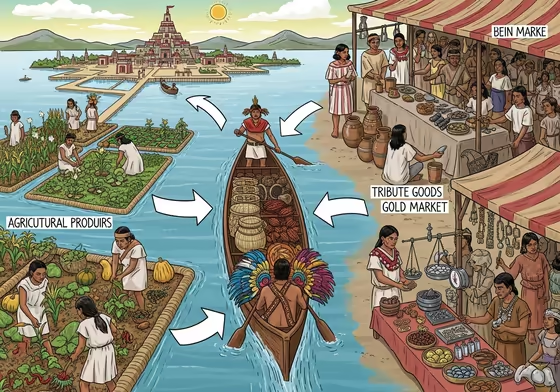
At the same time, the Aztecs had busy markets in every city. Here, regular people could buy and sell goods freely. This mix of government control and open markets helped the empire grow rich.
Their economy was built on three important pillars:
- Advanced Farming: The foundation of the Aztec state was its excellent farming. Using smart methods like the chinampa system, they grew huge amounts of extra food. This was needed to feed people in the cities, including priests, officials, and soldiers.
- The Tribute System: The empire got most of its wealth from tribute. Conquered cities were forced to regularly pay taxes in goods like food, cloth, and valuable items. This was the main way the Aztecs collected the resources of their empire in the capital.
- Trade and Markets: A large trade network supported the tribute system. Local markets provided everyday goods, while special long-distance merchants called the pochteca brought in luxury goods from lands outside the empire.
These three parts worked together in a cycle. Smart farming created extra food, which allowed for a professional army. This army conquered other cities.
The conquered cities then paid tribute, sending wealth to the capital. This wealth funded more wars and trade, making the empire even stronger.
The Aztec economy was very effective at supporting its huge city and army. The main market at Tlatelolco was amazing, with up to 60,000 people trading daily. But the system relied on forcing conquered people to pay tribute, which created a lot of anger.
This anger made the empire unstable and helped the Spanish conquer them later. The same system that made the Aztecs powerful also led to their downfall.
Three key facts explain the Aztec economy:
- They used a form of money, not just trading. They used cacao beans for small things and cotton cloth for larger purchases. This shows they had a good understanding of how money works.
- Their power came from amazing farming techniques. The "chinampas," or floating gardens, were so good they could produce several harvests a year. This farming skill supported their large population and army.
- The empire’s great wealth came from tribute. They collected goods and labor as taxes from the many lands they conquered.
Aztec Money and Currency
The Aztecs had a smart system of money that went beyond simple trading. They used different types of goods as currency for different kinds of purchases.
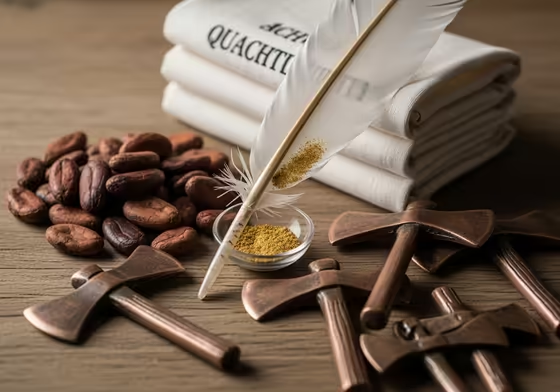
For everyday shopping, people used cacao beans. They were like small coins used to buy food or pottery. Some people even tried to make fake ones by filling the shells with dirt.
For bigger purchases, they used standardized pieces of cotton cloth called quachtli . These were valuable because of the work it took to make them. People used them to buy expensive things like land or slaves.
The Aztecs also used other forms of money for very valuable trades.
- Copper Axe-Monies ( Tajaderos ): These were T-shaped pieces of copper that looked like axe heads but were not used as tools. They were worth a lot, with one being equal to 8,000 cacao beans.
- Gold Dust: For some special trades, they used gold dust. It was stored in clear bird quills so everyone could see how much was inside.
This system shows the Aztecs understood money well. Cacao beans were like coins for small daily purchases. The cotton cloths were like large bills for major payments.
Axe-monies and gold dust were used for trading great wealth over long distances. They even had exchange rates between these different types of money, making it a true economic system.
Table 1: A Comparative Overview of Aztec Commodity Currencies
| Currency Type | Primary Material | Scale of Use | Known Exchange Value / Function |
|---|---|---|---|
| Cacao Beans | Seed of Theobroma cacao | Small-scale; daily market transactions | Used for purchasing food, small goods. Vulnerable to counterfeiting. |
| Quachtli | Woven Cotton Cloth | Large-scale; tribute, major purchases | 1 quachtli = 20 cakes of rubber. 20 quachtli could support a person for one year. Used to buy slaves. |
| Tajaderos | Copper or Bronze Alloy | High-value; regional trade | Shaped like axe-heads. 1 tajadero = 8,000 cacao beans. |
| Gold Dust | Gold | High-value; specialized transactions | Stored in transparent goose-quills for visible measurement. |
Trade and Markets
Trade was vital to the Aztec Empire. Their capital city, Tenochtitlan, was in a valley that could not grow things like cotton or cacao. They needed trade to get these important goods.
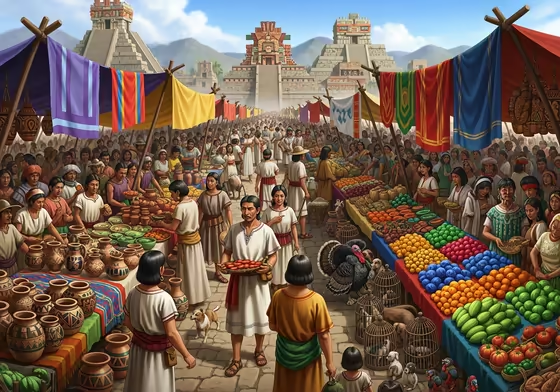
Aztec trade happened on two levels. First, there were local markets in every town, where people bought and sold everyday goods like food, tools, and medicine. These markets were also social centers where people gathered and shared news.
The second level was long-distance trade for luxury items. This was done by a special class of merchants called the pochteca . They traveled far beyond the empire to get rare goods like beautiful bird feathers, jaguar skins, and jade for the nobles.
The pochteca were more than just merchants; they were also spies for the emperor. Their travels allowed them to gather information about other lands. This information helped the Aztecs plan their military attacks.
An attack on a merchant caravan could even be used as an excuse to declare war. This shows how the Aztecs mixed trade with their plans for conquest.
Who Did the Aztecs Trade With?
The Aztecs traded with many different groups, especially the Maya peoples. It is important to know these were not the Maya of the famous ancient cities, which had already disappeared. The relationship involved trade, but also sometimes war.
A lot of the trade was indirect. Goods were passed from one group of traders to another, like a chain. This meant Aztec and Maya goods could be exchanged without the people ever meeting.
But there was also direct trade. Aztec pochteca met with Maya sea traders at special trading posts along the coast. The Aztecs wanted many goods from the tropical Maya lands.
Sometimes, the Aztecs chose conquest over trade. They conquered areas that produced valuable goods, like cacao, and forced the people to pay it as tribute. This was often easier and cheaper than trading for it.
Here are some of the key goods they exchanged:
- From Maya lands to the Aztecs: Maya lands provided tropical goods the Aztecs could not grow. This included cacao, colorful feathers, cotton, vanilla, and salt.
- From Aztec lands to the Maya: The Aztecs mainly traded obsidian, a volcanic glass used to make super sharp tools and weapons. They also traded other goods made in their cities.
What the Aztecs Valued Most
The Aztecs valued things very differently than the Spanish did. The Spanish wanted gold and silver above all else. The Aztecs often cared more about items with religious or social meaning.
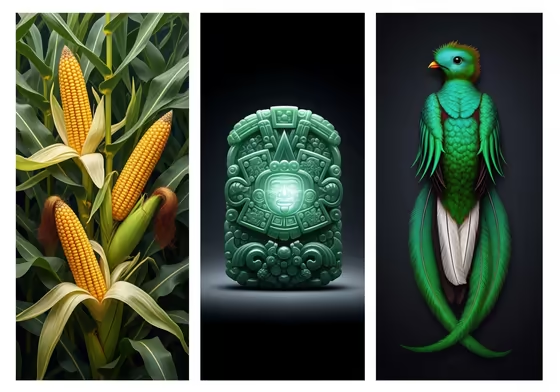
According to experts, the three things Aztecs prized most were maize, jade, and quetzal feathers.
- Maize: Corn was the main food for everyone and was seen as a gift from the gods. They believed it was the substance that humans were made from.
- Jade ( chalchihuitl ): This green stone was a symbol of life, water, and wealth. The Aztecs believed jade was more precious than gold.
- Quetzal Feathers: The shiny green feathers of the quetzal bird were used to make headdresses for emperors and priests. They were a symbol of power and holiness.
In a way, the most valuable thing of all was human blood. The Aztecs believed their gods needed human sacrifices to keep the universe going. This was seen as the ultimate offering to the gods.
Two other materials were key to how their society worked:
- Obsidian: This volcanic glass was like steel to the Aztecs. It was used to make extremely sharp blades for tools, weapons, and rituals. The Aztecs controlled the best sources of obsidian, which gave them great economic and military power.
- Textiles: Woven cotton cloth was not just for clothes. It was used as money for large purchases and was a common form of tribute payment. The quality of a person's clothes showed their social rank.
The Value of Gold
The Aztecs valued gold, but not as money. To them, its shiny color was beautiful and connected it to the sun god. It was used to make jewelry and decorations for temples and nobles.
The empire got its gold through tribute. They did not mine for it near their capital city. Instead, they forced conquered lands that had gold to pay it as a tax.
To the Aztecs, the value of a gold item was in its artwork, not just the metal. Today, any real Aztec gold artifact is priceless because the Spanish melted almost all of it down. The legend of Montezuma's lost treasure shows how fascinated we are with this lost wealth.
The Aztec word for gold, teocuitlatl , literally means "excrement of the gods." This name shows their belief that gold was a sacred substance from the earth.
The Most Important Crop
Of all the foods they grew, maize (corn) was the most important by far. It was the main part of every meal for everyone, from the emperor to the poorest farmer. Maize was also central to their religion and culture, seen as a sacred gift that gave life.
Farming and Food
The Aztec economy was built on amazing farming. They were expert farmers and engineers. They developed smart techniques to grow as much food as possible.
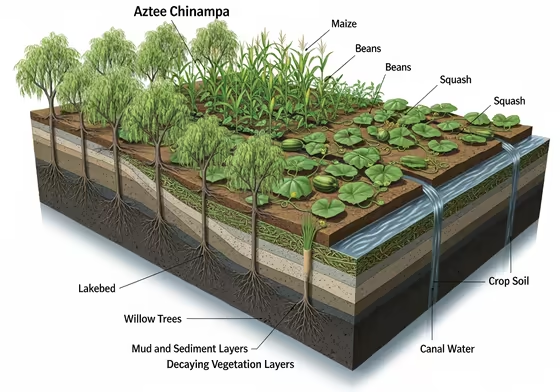
Their most famous invention was the chinampa, often called a "floating garden." They were actually man-made islands built in the shallow lake waters. Farmers built them by piling rich mud from the lake bottom into rectangular plots and planting trees to hold them in place.
This system was the key to the empire's success. It allowed them to create new, super-fertile farmland right on the lake where their capital was built. The chinampas were so productive they could be harvested up to seven times a year.
This huge surplus of food fed the cities and supported a large army. This army was necessary for the empire to grow and conquer new lands. Without the chinampas , the Aztec empire could not have become so powerful.
The Aztecs also used other farming methods. On hillsides, they built terraces to create flat ground for planting. They also built canals and aqueducts to bring fresh water to their fields.
How the Empire Became Wealthy
The Aztec Empire was incredibly wealthy. This wealth was concentrated in the capital and used to fund the government, army, and religious events. It came from two main sources: tribute and trade.
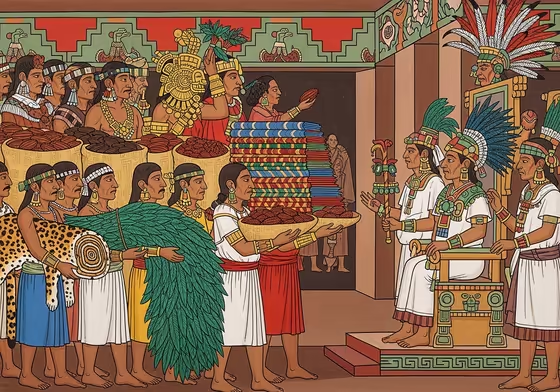
The tribute system was the most important source of wealth. After conquering a region, the Aztecs forced it to pay taxes in the form of goods. Huge amounts of food, cotton cloth, feathers, and gold flowed into the capital every year.
The government also controlled trade. Long-distance merchants brought back luxury goods from faraway lands. The state also collected taxes from all the buying and selling in the busy city markets.
The Aztecs saw wealth as a constant flow of goods, not a pile of gold. Their power came from controlling this flow of tribute and trade. This wealth was immediately used to support the empire, not stored away.
This system was powerful but also fragile. It completely depended on their military power to keep the tribute coming.
When the Spanish arrived and broke their military control, the flow of goods stopped. Without this constant flow of resources, the empire collapsed quickly.